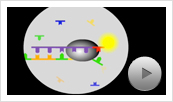Plexor® qPCR and RT-qPCR Systems Applications
Abstract
Plexor® technology takes advantage of the highly specific interaction between two modified nucleotides for qPCR analysis. These two novel bases, isoguanine (iso-G) and 5-methylisocytosine (iso-C), form a unique base pair when incorporated in double-stranded DNA and pair only with each other. In Plexor® reactions, one PCR primer is synthesized with an iso-C residue and a fluorescent label at the 5´-end. The second PCR primer is unlabeled. Iso-dGTP nucleotides, modified to include dabcyl as a quencher, are included in the reaction mix. During amplification, dabcyl-iso-dGTP is preferentially incorporated at the position complementary to the iso-C residue. Incorporation of the dabcyl-iso-dGTP in close proximity to the fluorescent label effectively quenches the fluorescent signal. Using Plexor® technology, the accumulation of amplification product results in a reduction in fluorescence that is proportional to the quantity of the input DNA template. Real-time instrumentation, which couples fluorescence detection and thermal cycling, measures the change of signal (in relative fluorescence units, RFU) at every cycle.
 The Plexor® Systems are a new way to perform quantitative PCR.
The Plexor® Systems are a new way to perform quantitative PCR.